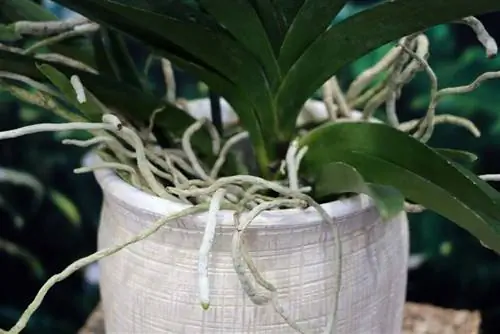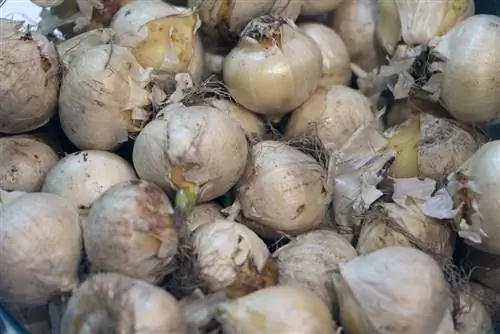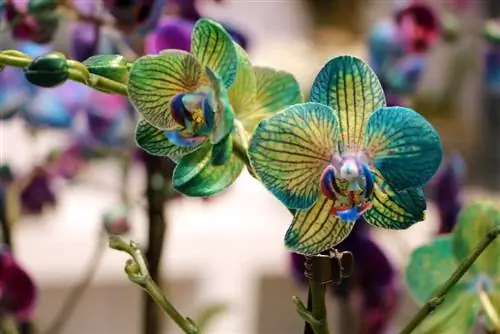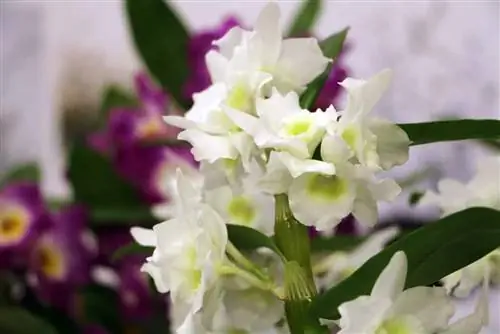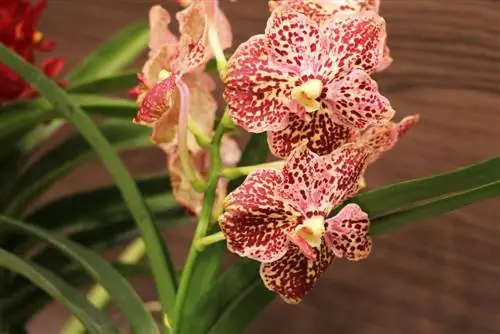- Author admin [email protected].
- Public 2023-12-17 03:39.
- Last modified 2025-01-24 12:45.
Many species of orchids develop aerial roots. These are mainly the epiphytic orchids, especially the types of Phalaenopsis orchids. Epiphytes are epiphytes, plants that sit on other plants. They absorb water and nutrients through their aerial roots. They also give them support on the branches of their host plants. Orchid lovers pay just as much attention to the aerial roots as the rest of the plant. Proper handling of the roots is important for he althy leaves and lush flowers.
Function and appearance
The aerial roots of epiphytes have the special ability to absorb water and nutrients from the air. A spongy layer of cells (Velamen radicum) ensures the absorption and storage of the vital basics. This special outer cell layer absorbs water and mineral s alts from the air, dust and rain. Thanks to their stable and adaptable structure, the aerial roots also offer the orchids secure support on their host trees and shrubs. Depending on their abilities, they are also called adhesive roots or respiratory roots. In orchids that are cultivated as houseplants, the roots ensure sufficient support in the substrate. The less nutrients and water they get from the substrate, the more criss-crossing aerial roots form outside the container. In some types of orchids, the roots have a slightly greenish shimmer and contain chlorophyll. This means they can continue to process nutrients even at times when there are few leaves due to the climate. The roots of orchids hardly show any branches, but they tend to grow in a criss-cross pattern. At the end of each growing season, new roots are formed.
He alth
If you want to find out which roots are still alive and he althy, the best way to check is to spray the roots with water. Then most of the roots turn green. It is also easy to see whether water is being absorbed because the color and shape change slightly. The roots should have a plump and smooth surface.
Rotten roots
Too much moisture or constant watering right into the heart of the orchid can cause the roots to rot. The rotten roots must be removed. If there are still enough he althy roots and you keep the plant a little drier in the future, it will be able to recover completely.
Dead, withered roots
It is completely normal for roots to die over time. It is not necessary to remove them immediately; they can often still serve as a support for the orchid. With the water sample you can see which roots are already dead (i.e. completely dry) and you can remove them if they become excessive or visually disturbing. However, roots that look dry should not be removed immediately. Maybe too little (air) humidity is the reason. They often get green tips again as soon as the humidity is increased. Regular spraying or having a container of water nearby can help and revitalize the roots if they are not already completely dead.
Care
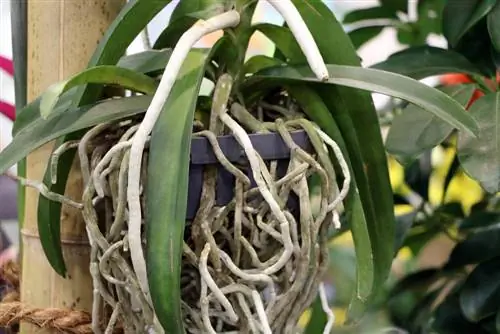
To ensure the highest possible humidity, spray the orchid, including its aerial roots, with a fine mist of stale water. Of course, this process does not replace regular watering. It's best to spray in the morning so that the water can evaporate throughout the day. The mixture with the liquid orchid fertilizer can also be sprayed onto the aerial roots using a spray bottle.
Cutting
Basically, you should never simply cut around the aerial roots of an orchid. Only dead or rotten roots are professionally removed. It may only rarely become necessary to remove he althy aerial roots for aesthetic reasons or for reasons of space. In this case, only a few strands may be removed from each plant, otherwise it will no longer be adequately supplied and the orchid will die. In most cases, a he althy orchid does not form more roots outside the substrate than inside. Too many aerial roots are a sign that the orchid is no longer getting enough moisture or nutrients from the substrate:
- This could be due to the substrate. Maybe it is too old, has already rotted and has become compacted around the roots. Remedy by immediately repotting into fresh substrate.
- Or the plant simply does not receive enough moisture and nutrients. It helps here to add more water and fertilizer to the substrate.
Separating aerial roots:
- The tool (knife, scissors) must be sharp. This prevents the interfaces from fraying. An orchid knife or a scalpel-like knife is preferable to scissors.
- The tools are first disinfected with boiling hot water or high-percentage alcohol. This reduces the risk of germs entering through the interface.
- The best time for pruning is the rest period. The time after an orchid blooms.
- The interface, which is to be viewed as an open wound, should be coated with charcoal powder immediately after the cut. This reduces the risk of fungal pathogens gaining access from there.
Repotting
If the substrate is used up after two to three years, the orchid is repotted. A relatively large number of aerial roots are also a sign that it needs to be repotted. This is also the best opportunity to remove dead or rotten roots. After the plant has been potted out, the old substrate is carefully removed from the roots. So that no roots break off when inserting into the new substrate, place all roots, including the aerial roots, in lukewarm water for up to 10 minutes. They become so supple and don't break when you move them. Now carefully screw in all the roots (including the aerial roots) in the new pot. Then you add the new substrate.
Tip:
Never choose your new pot too big. The most important thing about repotting is the new substrate. The roots have better support in small pots. If you choose a transparent pot, more light reaches the roots and you can see them better.
Species
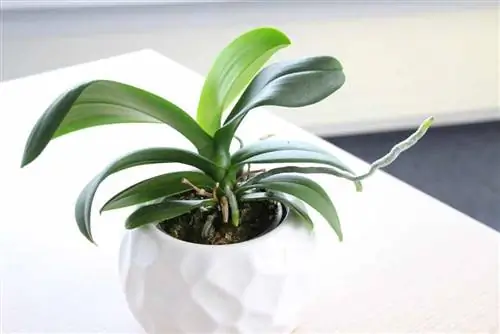
Different types of orchids also develop different roots. Not all orchids are suitable for growing in pots; not all of them develop aerial roots. The thickness and texture of an orchid's roots can be used to draw conclusions about its specific needs.
Dracula, Masdevallia
These species form very thin roots (up to one millimeter), they require a lot of moisture and must never dry out completely. The roots can be placed in a substrate, but also grow outside.
Dendrobium, Oncidium
The roots of these species are still quite delicate, up to 3 mm in diameter. They form many aerial roots, but can be cultivated better in pots. They love it moist and rather cool.
Cattleya, Phalaenopsis
The roots grow up to 6 mm thick. They are mostly cultivated in pots here. Many aerial roots are a sign that the plant needs new substrate.
Aerides, Vanda
The aerial roots of these species grow thick, sparse and are not cultivated in pots. They don't need too much moisture. In their Asian homeland, morning and evening dew are enough for them. The genus Taeniophyllum has flattened, chlorophyll-containing aerial roots. These are able to take on the function of leaves. You need the light.
Paphiopedilum, Phragmipedium
Growing these species is not that easy. The roots are hairy and are cultivated in soil. They do not form aerial roots. Be careful when repotting, the roots are very sensitive and break easily.
Conclusion
Not all types of orchids are really easy to care for. If you want to enjoy your orchids for a long time, sooner or later you will have to deal more intensively with the special needs of these special plants. This includes the correct handling of the aerial roots. The most important rule to avoid doing anything wrong here is: Don't simply cut off he althy aerial roots. High humidity, good nutrient supply and regular fresh substrate are already a good basis for he althy orchid roots.

